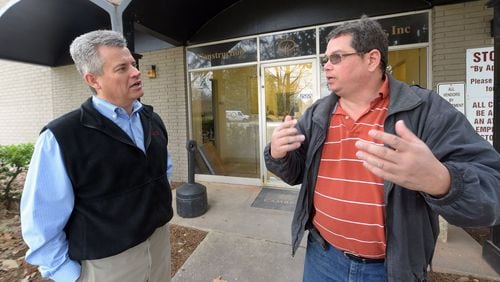Embedded in the immigration debate is a potential Catch-22: Restricting the supply of foreign-born labor could undermine the Trump administration’s promise to goose economic growth.
Some businesses already are seeing the labor market tighten, which can raise costs and crimp expansion.
“Every aspect of our industry needs workers,” said Michael Dunham, chief executive of Associated General Contractors in Georgia. “Immigration is clearly a factor. We have a native-born workforce that is not growing fast. People here are having smaller families. We are going to have to address this.”
One reason for sluggish economic growth is demographics – the massive boomer generation is steadily leaving the workforce, former Atlanta Fed chief Dennis Lockhart noted in an interview just before he left the job last month.
Growth — which Trump vows to boost to 4 percent, double or more the recent rate — depends on productivity, hours worked and the number of people working. All are growing slowly.
“We don’t have a wind at our back simply in terms of the number of people working in the country,” Lockhart said. “I don’t want to wade into a political battle, but … if you really want to address the rate of growth of the workforce, the number of people working, one of your options would be immigration.”
It’s unclear how Trump administration policies will unfold, but the rhetoric seems aimed at restricting the flow of both legal and undocumented residents. Proposals or discussion has included “extreme vetting” of immigrants; limits on programs for engineers and scientists; and more aggressive deportations of undocumented workers.
In Congress, Georgia Republican Sen. David Perdue is co-sponsor, along with fellow Republican Tom Cotton of Arkansas, of a bill that would cut legal immigration by about half — focusing on lower-skilled workers who they contend are driving down wages.
“Returning to our historically normal levels of legal immigration will help improve the quality of American jobs and wages,” Perdue said in announcing the legislation last month.
Many Americans support tighter immigration controls, whether to prevent terrorism or trim job competition.
But some economists worry. Immigrants not only supply labor, they note, but also add to U.S. consumption. They tend to be younger, which means they are more likely workers and spend more as they start families. At the same time, they also send more children to public schools.
Trouble filling jobs
Atlanta-based Construction Resources, which designs and makes building products, already has trouble filling some jobs, such as machine operators and installers, said Mitch Hires, chief executive.
As a result, the 750-employee company doesn’t take advantage of all projects available, Hires said.
“It delays growth and it hurts our profitability,” he said.
“Right now, I don’t know if I would directly correlate immigration with the shortage of labor,” Hires said. “But six months from now, when we look back, it may be something that stands out.”
The unemployment rate has fallen nearly to pre-recession levels and the pool of unemployed has shrunk, so it has grown harder to find workers. Skilled employees have gotten scarcer, Hires said.
“And when the push comes, in April, May and June, I think it is going to get harder to find people,” he said.
Doug Rieder, president of Sterling Risk Advisers, an Atlanta-based insurance brokerage firm that works with about 400 contractors, doesn’t think it’s a passing phase.
The firm takes surveys every six months, and “in our three last surveys, labor availability was the number one issue,” he said.
Self-selected out
Many foreign-born workers, especially those with limited English skills, typically take lower skill occupations. As oversight of hiring has become more rigorous, a lot of the undocumented labor “just self-selected themselves out,” Rieder said.
Tighter labor means higher pay and costs for companies. That translates to prices, Dunham said.
“Costs are going to be higher … sometimes you just have to pay overtime to get a project done.”
Several studies have shown that H-1B visas – used for tech workers and scientists – dampened wages by several percentage points for similar U.S.-born workers.
But the argument for the economic benefit is also strong: nearly half of the U.S. innovators responsible for America’s “most consequential innovations” are immigrants or children of immigrants, according to the Information Technology and Innovation Foundation.
Historically, America’s attitude toward immigration has been erratic. In some eras, immigrants poured in; other times, the gates nearly closed.
The current debate spotlights both ends: At the low-skill end are workers – largely from Latin America – who take jobs in the fields, construction sites, hotels and restaurants. At the other are those with degrees, typically from India, China or Europe, who often staff software and healthcare jobs.
Critics say both types threaten American jobs and wages. Businesses generally argue that they are needed.
Significant numbers
Foreign-born workers are already a significant part of the picture, said Wesley Tharpe, research director at the Georgia Budget and Policy Institute.
A 2015 report from the GBPI showed 26 percent of the state’s software developers and 23 percent of doctors were immigrants. There were no precise numbers for laborers and service workers, but that is where most foreign-born workers are, he said.
“They are filling both the higher skill occupations as well as the low-skilled frontline jobs, doing day-to-day work that makes the economy run,” Tharpe said.
Rajeev Dhawan, director of the Economic Forecasting Center at Georgia State University, said less immigration pushes up wages and costs in the short run, but spurs more automation as time passes.
“Artificial intelligence and automation are going to grow leaps and bounds,” he said. “You can still have higher growth if you have intensive use of capital.”
However, not everything can be done by machine, Dhawan said.
“If the price goes up, maybe it’s time for hotel guests to make their own beds. And who is going to pick up the produce in the field?”
Georgia's foreign-born population:
1990: 2.7 percent
2000: 7.1 percent
2013: 9.7 percent
Share of Georgia workers who are immigrants:
13 percent (2013)
Share of workers who are unauthorized immigrants:
7 percent (2012)
Current immigration to U.S., legal and illegal:
about 1 million per year (0.3 percent of U.S. population)
_______
*Age 25 and older
Source: Census Bureau, American Immigration Council, Bureau of Economic Analysis
Immigration’s effect on wages of U.S.-born workers, 1990-2010
Immigration has a mix of effects. More spending means more demand for some jobs, but new workers add competiton for other kinds of positions. Research shows immigrants put downward pressure on American wages at the top and bottom of the skills scale, while boosting those in the middle.
People with no degree -1.7 percent
High school degree +0.9 percent
Some college +1.2 percent
Bachelor’s degree +0.5 percent
Graduate or professional degree -0.1 percent
Source: study by George Borjas, Kennedy School at Harvard University







